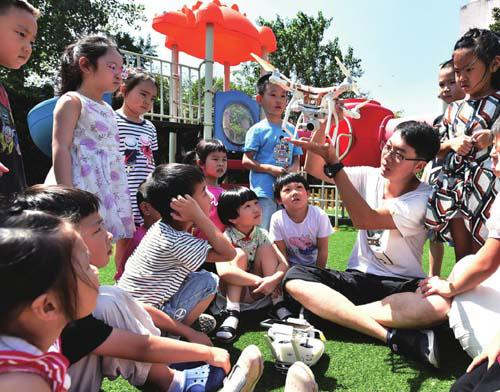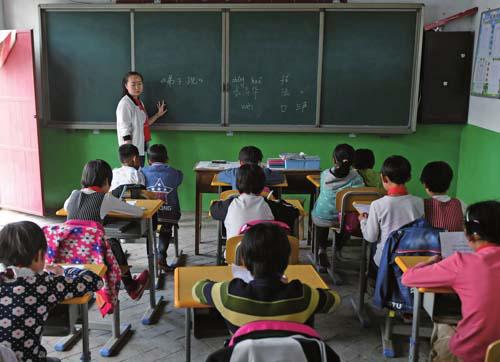Aiming High
By Wang Hairong


Liu Wenge, headmaster of Beichen District Model Primary School in Tianjins suburbs, recently had a feeling that his dream was coming true. He had wished that rural children at his school would enjoy an education equal to their city peers. Now, with newly built stylish classrooms and modern education facilities, his school looks no different from an urban school.
Increased government funding refl ects the high level of attention that China has given to education. At a national conference on education held in Beijing on September 10-11, President Xi Jinping reiterated the importance of education and called on the whole nation to give full respect to educators.
“China has given priority to education, which is an important cornerstone of national rejuvenation and social progress,”said Xi at the conference, as the country marked its 34th Teachers Day.
Education is also vital for promoting peoples all-round development and making the country more innovative, he said, and it will benefit not only contemporary society, but future ones as well.
Xi acknowledged educators contribution to national development, praising them as the shapers of souls, transmitters of civilization and disseminators of knowledge, stressing that they should be respected and their political, social and professional status should be enhanced.
While accelerating education modernization and building a country educationally strong, the government should take a highstanding and long-term historical view and a broad international perspective, and develop sharp strategic insight, he said.
The president also emphasized the leadership of the Communist Party of China(CPC) in educational affairs and pointed out that the fundamental task of education is to nurture socialist builders and successors.
Deepening reform
At the conference, Xi also called for deepening reform of the educational system, adding that education evaluation methods should be reformed and the stubborn disease of only looking at scores, admission rates, diplomas and theses should be removed.
He also mentioned deepening education management reform, building worldclass universities and disciplines, promoting greater integration between industry and education, and encouraging cooperation between Chinese universities and topnotch universities around the world.
For decades, China has carried out reform to shape up its educational system. Recent educational reform goals and measures have been detailed in an Outline of Chinas National Plan for Mediumand Long-Term Education Reform and Development (2010-20), a blueprint released in July 2010.
According to the outline, the strategic educational goal is to basically realize education modernization by the year 2020, when a learning society will take shape and the country will become rich in human resources.
The plan has specific tasks for various stages and types of education such as preschool, compulsory, university, vocational, lifelong and special education. For instance, the key tasks at the compulsory education level are to improve education quality and enrollment, promote equity and reduce course load.
In 2013, the Ministry of Education(MOE) issued a notice on national education pilot reform, pinpointing 10 major tasks, which included accelerating the development of preschool education, promoting the balanced development of compulsory education, reducing the schoolwork burden of primary and secondary school students, and reforming universities teaching and operation models so as to build modern universities. The other four measures are reforming the mode of running vocational schools, creating a more favorable environment for private educational institutes and improving the management of teachers and the educational investment mechanism.
To further the reform of the education system and educational mechanisms, in September 2017, the General Offices of the CPC Central Committee and the State Council issued the Opinions on Deepening the Reform of the Education System and Mechanism. It stated that by 2020, a dynamic, efficient, more open educational system that promotes scientific development will be formed, while public concerns on education will be addressed.
In addition to establishing reform measures in teaching methods, management models and assurance mechanisms, the document emphasized moral education guided by socialist core values. These reform measures have been rolled out across the country and have now yielded results.
Promoting equity
When computers were brought into Lianhu Primary School in Xingan County, east Chinas Jiangxi Province, they caused a stir in the school, since it had never had such hi-tech equipment before.
In recent years, the county has furnished every classroom in its 77 primary schools with computers, as well as new desks and chairs. New classroom buildings, dormitories for teachers and students as well as dining halls have been added, replacing previously dilapidated structures.
While access to the nine-year compulsory education system across the country has become available, the government is making efforts to promote education equality among different regions, between urban and rural areas and among schools.

Statistics from the MOE showed that since 2013, approximately 260,000 schools across the country have been either newly built, renovated or expanded, accommodating 27.25 million more students, while 1.72 million teachers have been added. A national assessment by the education authority showed that as of the end of 2017, the development of compulsory education was balanced in 81 percent of county level administrative units across the country.
In 2018, 80 percent of the fi scal transfer of the Central Government went to rural areas in central and western regions and poverty-stricken areas. After being renovated, 94.7 percent of schools providing compulsory education met the basic standards for teaching facilities, according to the MOE.
But hardware alone is not enough to make a school competitive. Qilidian Primary School in Daming County, north Chinas Hebei Province, has modern facilities, yet years ago, many local students still chose to go to other schools despite the impressive hardware. “The teachers teaching methods were outdated, and so the education quality could not be assured,” a teacher at the school said.
In 2015, under a policy promoting the coordinated development of urban and rural schools, Qilidian Primary School became a subsidiary of a quality school. The teachers there received more training, and eight quality teachers were sent to the school. With teaching quality remarkably improved in just two years, student enrollment has grown from its lowest level of 172 students to more than 700 at present.
In 2015, to attract and retain rural teachers, the MOE released a Rural Teachers Supporting Plan (2015-20), increasing their incomes and opportunities for career development.
From 2016 to 2017, more than 3.6 million headmasters and teachers in rural middle and primary schools received professional training, said Education Minister Chen Baosheng in a report delivered to the Fifth Session of the 13th National Peoples Congress Standing Committee in August.
Zhang Chao, a teacher in Huangchuan County, Xinyang City, central Chinas Henan Province, said that the rural teacher training courses were colorful and tailored to the actual needs of the teachers. In addition, he said that in the past fi ve years, his monthly income has increased by nearly 1,000 yuan ($146).
While the gap between urban and rural education is narrowing, in cities, especially large ones, parents are fiercely vying for better local educational resources, mainly by buying property in good school districts and sending their children on training courses.
In Beijing, the district-level education departments have taken a variety of measures to equalize education resources. In Haidian District, for example, some weak schools have been annexed into good schools to improve their teaching quality, while graduates of primary schools are randomly assigned to nearby middle schools through a computer system in order to realize balanced student sources for middle schools.
Reducing students burden
Shanghai students taking part in the Program for International Student Assessment reportedly spent 13.8 hours on school homework every day, almost doubling the average of seven hours for students in countries under the Organization for Economic Co-operation and Development.
To reduce students burden, in 2013, the MOE issued a document stipulating that fi rst to third graders should not be assigned written homework, while homework for fourth to sixth graders should take no more than an hour to complete.
After-school courses have added burden to Chinese students. Chinese parents attach great importance to education and they tend to believe that knowledge changes fate. They are willing to spend a significant share of their income and energy on their childrens education. Some have joked that in their spare time, they are either accompanying their children in afterschool training institutes or on their way to such institutes.
Tiantian, a primary school student in Beijing, is a busy girl. In addition to regular course work, the 9-year-old is taking afterschool English, Chinese and Olympiad Math, as well as fi gure skating, singing, ballet, swimming and piano lessons. She has won national awards in singing and figure skating. Her mother told Beijing Review that she spends about 100,000 yuan($14,600) a year on her daughters afterschool classes.
In some after-school classes, students are often taught content which is too advanced for their age. Homework is assigned after each class.
To address this problem, since this February, the MOE, together with three other relevant government departments, has launched an initiative to strengthen the regulation of after-school training institutes.
These institutes are required to report detailed curricula, teaching plans, recruitment plans and course schedules to local education departments and release the information to the general public. The training contents should not be more advanced than comparable government standards. Classes should not run later than 8:30 p.m. and no homework should be assigned. Training institutes are forbidden to organize examinations or competitions on subjects taught at primary and middle schools. They are not allowed to charge tuition for more than three months of enrollment.
According to the MOE, as of August 20, 382,000 training institutes had been inspected, and 259,000 of them were found to have problems and ordered to make corrections.
Moreover, in March, the MOE repudiated the policy of giving bonus points to students winning national mathematical or other Olympiads for university application. This is expected to dampen the zeal for after-school training in preparation for such events.
Reforming teaching methods
Chinas education has long been examina- tion-oriented. High school students need to take the National College Entrance Examination (gaokao) to enter university, and a students total score in all tested subjects is the sole criterion for university admission, which is prized for its impartiality toward a majority of students but which has also created problems. The traditional educational method is also thought to reward rote memorization while stifling creativity.
In 2007, Fudan University and Shanghai Jiao Tong University started independent enrollment before the gaokao, with the method later adopted by other top universities. Under this special enrollment arrangement, a prospective student is given a chance to take an exam or interview designed by the university. Those who pass the special exam or interview get a bonus score to be added to their gaokao grade, so that they will have a better chance of getting admitted to these top colleges.
In 2008, Jiang Fangzhou, a gifted writer from early childhood, was admitted to Tsinghua University through this type of in- dependent enrollment. She began writing at the age of 7 and by the time she entered college, she had already published nine pieces.
The national outline from 2010 also spelled out the countrys plan to reform the university admission policy, stating that letting the gaokao determine ones fate should be avoided, while education for allround development and creativity should be pushed forward. Methods should be explored to weaken the role of the gaokao score in the university admission process in a way conducive to the appropriate selection of talented people, students sound development and maintenance of social equity.
In recent years, the subjects to be tested in the gaokao and their respective weight on the overall score have been revised from time to time. Nonetheless, the country is still searching for a better way to improve its university admission.
In compulsory education, students are now given an assessment of their overall development at the end of the semester. The assessment includes aspects such as moral conduct, physical quality, psychological quality and special skills, in addition to subject-specifi c performance.

